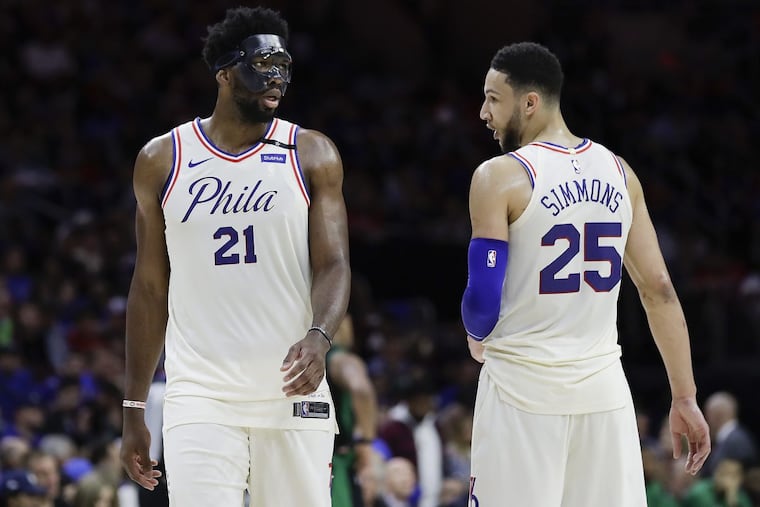The real story of Sixers-Celtics? It's simpler than some think | David Murphy
You can assign the blame to "youth" or "coaching" or "mentality," but the reality is this team is not what we thought.

It was a gray day on the other side of the river, the sky slung low in milky furrows. Barely 12 hours after the stunning arrival of their season's terminal phase, the Sixers gathered at their training complex on the east bank of the Delaware and began the process of postponing what history holds to be the inevitable. Their words suggested optimism, but their tone betrayed a somber grasp of the reality that now confronts them. Staring up from a three-games-to-none hole, the Sixers' biggest hurdle isn't the decades of precedent that says they are dead, but the psychological baggage of knowing they were the killer.
After Saturday's self-inflicted 101-98 loss to the Celtics, Sixers players spent part of their evening exchanging text messages of reaffirmation on the group chat thread to which they all belong. The process continued Sunday morning, when they gathered for a film session that included an open-mic brainstorming session in which Brett Brown solicited input from his players. The team did not provide a transcript of the meeting, and the head coach declined to elaborate on the topics discussed. But the two most recent games of this best-of-seven series hardly suggest the Sixers are a group in need of reinvention. More than anything, they are a team in need of a little more luck.
Given the way Game 3 ended, with a couple of crucial turnovers in the closing moments, it might seem difficult to train a critical focus elsewhere. But the reality is that the Sixers did enough things right in the first 46 minutes of action that it never should have come down to the final seven.
This starts in the post, a place that was the topic of a lot of discussion on Sunday thanks to the 10 of 26 shooting line that sat on the stat sheet next to Joel Embiid's. While such a mark is hardly a picture of efficiency, the Embiid-centric half-court attack the Sixers utilized in Game 3 was actually their most competent and sustainable plan of the series.
More than the turnovers, or the inability to guard Boston's inbound plays, their undoing came in the form of their repeated failure to finish at the rim. According to the play-by-play data, the Sixers missed 14 shots within four feet of the basket, a number whose enormity hits home when you compare it with the Celtics' performance in that department. Both teams finished with 17 makes around the rim, but Boston did it on just 21 attempts. The Sixers did it on 31.
Game 3 shots within four feet of the rim
A lot of those misses came by way of Embiid, including five layups or tip shots he either missed or had blocked, and nine others he attempted inside 13 feet.
"I missed a lot of easy ones," Embiid said. "I think a lot of it is on me."
But it wasn't just Embiid who struggled to finish in traffic. There was Ben Simmons doinking an attempted dunk with an Exodus-sized path to the basket, one of five he missed within arm's length of the rim. Robert Covington's 0-for-8 shooting night included a missed tip shot and a missed alley-oop. Compare all of that with the Celtics' Jayson Tatum, who missed just one of the eight shots he attempted inside 11 feet.
In the search for answers, there is a tendency to overdramatize things, a phenomenon that is often the product of psychological deflection, since such searches are generally conducted in the wake of an outcome that defies our hypothesized reality.
In the present case, the struggles we witnessed the Sixers endure in the first three games of the series did not jibe with the way most of us appraised their talent level at the outset. Given the mind's natural predilection toward self-confirmation, it attempts to bridge the disconnect in a way that minimizes the errancy of that initial appraisal. Thus, it gravitates toward the abstract, and things it could not have predicted. If we assign determinant status to "youth" and "coaching" and "mentality," we can avoid an admission that the sum of the parts of this team is not the whole we thought.
No doubt, those variables exist, but their relevance exists primarily on a concrete level. Embiid and Simmons don't need 40 days in the desert with JJ Redick. They need repetitions. Embiid needs to continue to develop the muscle memory that will enable him to maximize his prodigious gifts with his back to the basket. The leverage, the footwork, the ability to see without looking. The low block is a dance floor, and you learn it by doing.
Likewise with Simmons. Consider the linear improvement of Kevin Durant's field goal percentage inside four feet during the first four years of his NBA career: Year 1: .607, Year 2: .677, Year 3: .703, Year 4: .795.
Turnovers happen, and, yes, they tend to happen less frequently as youth gets older. But they also diminish in impact, because attempts that once rimmed out gradually become buckets, and those buckets become bigger margins for error in a game's closing minutes.
"I missed seven or eight hook shots," Embiid said. "As a big man, I should really make those. If you take those back, you don't really talk about me being inefficient in the post. I just have to do a better job of making shots."
The percentages hold that last observation to be the real story of this series. The Celtics have shot .461, the Sixers .415. Now, the Sixers must prove history's percentages wrong.